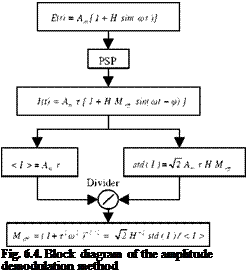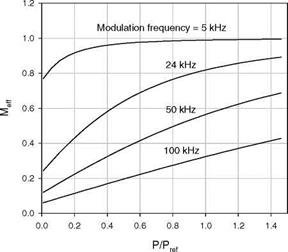Amplitude Demodulation Method
 |
|
The amplitude demodulation method was used for fluorescent lifetime measurements of tagged biological specimens in a flow cytometer (Deka et al. 1994). For the sinusoidally modulated excitation light, the luminescent response is given by Eq. (6.7) and the effective amplitude modulation index is M eff = (1 + t2 m2) ~1/2. Clearly, for a fixed modulation frequency, the lifetime can be obtained from measurement of the effective modulation index. Combination of the Stern-Volmer relation Eq. (6.10) with Meff = (1 + т2m2) ~1/2 yields an expression for pressure as a function of the effective amplitude modulation index Meff
where tmax and tmin were the times at which the modulated oscillating luminescent signal went through the maximum intensity Imax( tmax) and minimum intensity
LiJ tmin ) , respectively.
Here, as illustrated in Fig. 6.4, a simpler scheme is proposed to determine Meff by calculating the time-averaged quantities of the modulated luminescent signal. Define the time-averaged oscillating luminescent signal
1 CT
< I >= Lim— I I(t)dt. (6.19)
T2T J-t
The mean and standard deviation of the luminescent intensity I(t) are < I >= Am t and std(I) = < (I-< I >)2>1/2 = Am тHMeff/-[2 . Therefore, taking a ratio between these quantities, we obtain a simple formula for the effective amplitude modulation index Meff = (1 + т2 m2) ~1/2
![]() Mff =42h -1 = < E > 1ША
Mff =42h -1 = < E > 1ША
eff < I > std(E) < I >
It is emphasized that Eq. (6.20) is valid only for the sinusoidally modulated excitation light E(t) = Am [ 1 + H sin( m t)] . Instrumentation for utilizing this
methodology is particularly simple since only the mean and standard deviation of the sinusoidal luminescent intensity and excitation light intensity are required.
The optimal modulation frequency can be obtained by maximizing the sensitivity of Meff to pressure
 |
For a typical PSP, Ru(dpp) in GE RTV 118, having the lifetime т = 4.7 |J. s at the ambient conditions, the optimal modulation frequency is 41 kHz. Figure 6.5 shows the effective amplitude modulation index Meff as a function of the relative
 |
pressure p/pref at different sinusoidal modulation frequencies for this PSP having the lifetime t = tref/(0.17 + 0.84p/pref). Clearly, the selection of the modulation frequency affects the performance of the system.
|
Fig. 6.5. The effective amplitude modulation index M eg as a function of relative pressure |
at different sinusoidal modulation frequencies for Ru(dpp) in GE RTV 118 for T = 20oC and p = 1 atm












